Greek Odyssey - Pt 1, Athens
- Faisal

- Mar 27, 2022
- 13 min read
Updated: Apr 7, 2022
Yassu Greece!
Finally my European adventure is underway. The first stop on the tour is historic Athens in Greece. I arrived here late in the evening and got a taxi straight to the hotel. One of the reasons for booking a hotel in downtown Athens was that it was close to most attractions, which is useful, but it also boasted a rooftop bar with an impressive view of the Acropolis. I have to say I was not disappointed:

It is in fact, a modern, luxurious complex which also had very good reviews online. I had booked into the "Superior Suite" but when I arrived at the hotel they informed me of a complimentary upgrade. I was now in the Penthouse suite which was more spacious and included an ensuite for the main bedroom, oh and there was complimentary wine! This was always going to be a comfortable stay to begin my trip, but it had just become Luxury++
So now it was time to start thinking about what I was going to do tomorrow. When I was doing my planning in the UK, I had jotted down few of ideas, with the Acropolis and Parthenon marked out as the must-see attractions, but all my assumptions for sightseeing were based on fine weather in Athens. As it turns out, March can be a bit variable here - it is the transition from Winter to Spring and I had arrived on the last day of Winter :/. I checked the forecast for the next day and it was looking cloudy and rainy, so undeterred, I decided that Acropolis maybe off the table for now but I could still go for a walk and get my bearings, and worst case scenario stay in my hotel room and plan the rest of the week. However, as I was messing around on Google Maps I stumbled across the Free Athens Tour company and decided on the spot to try and book myself in for the 10am tour. Walking tours are always a good way to explore a new city regardless of the weather so I thought it was worth a punt.
The next job to sort was dinner. I sought a recommendation from the hotel and they pointed me to Dopios, which was around the corner. They accommodated me very well (although it was not that busy), it was a nice atmosphere with authentic Greek music playing softly in the background. The food was authentic but with a twist, all dishes were served as small plates (think tapas), it was my first chance to sample the vegetarian dishes of the Mediterranean. I opted for Hummus, Cheese croquettes and the Trachanas with halloumi cheese cubes.
After dinner it was time to call it a night after a long day of travel so I went back to my room to get rested up for my first proper day in Athens tomorrow.
Day 1 - Walking Tour
I got up extra early to try the breakfast buffet in the hotel and checked my emails to see if I could do the walking tour. I saw an automated notification from last night, followed by confirmation of a free tour booking with the meeting point - The Church of Sotera Lykodemos. The meeting point was only about 15-20 mins walk so after finishing breakfast I made my way there. It was rainy and windy on the journey to the Church, but any misgivings I had about this tour was put to rest by the two enthusiastic tour guides, the main guide was a student from Scotland (which was interesting in its own right) and a local Athenian providing additional support. It was a mixed group with Americans, Germans and Israelis but they conducted the tour in English.
We made our way from the Church to our first stop which was Byron's statue, next to the National Gardens. It is interesting that Greece commerates a 19th century British socialite, poet and romantic, but it turns out he was a very big supporter of Greece. He studied here and also lived here, always campaigning for preserving its ancient history and promoting its status across Europe. He donated half of his immense wealth to the people of Greece and on his deathbed there is an apocryphal tale of his only regret being that he did not donate his entire estate. We quickly moved on to the Zappeion Hall nearby which is just within the boundaries of the National Gardens. This magnificent hall was founded by the Zappas brothers who had generously donated to various projects around Greece, not least the construction of this hall in the 1880s in order to fulfil their lifetime ambition of reviving the Ancient Olympics. This hall served as the first Olympic Village back in the 1896 for the inaugural modern Olympic Games. To continue the Olympic theme we then walked through the gardens and towards the Panathenic Olympic Stadium. This was the very first Olympic Stadium used for hosting live sporting events, the site itself was chosen based on a long history of sporting competition, spectators have enjoyed events from the two hills on either side of the stadium dating back to 700 B.C. - this spot in Athens was chosen for good reason!
The stadium was prepared for the 1896 Olympic Games in Greece and is still used to light the eternal flame. As per Olympics tradition, every 4 years the delegated torch bearers for the next host nation must light the flame here before carrying the torch to their respective cities for the torch relay. We then moved on to the Presidential Palace, not a lot to say about this place other than the interesting uniform of the military guards and their strict adherence to statue-like posture - there were a couple of stories regarding molotov cocktails being thrown at the guard house (it was on fire) during the austerity protests which did not faze the guards and they had to be removed by their superior
An interesting stop on the tour was the Academy of Athens. It is a beautiful building which is based on contemporary european architecture, apparently the architect was involved in designing buildings in Vienna. The academy which celebrates knowledge, history and culture has several notable statues, the first to greet you are two large statues of the philosohophers Plato and Socrates. There are 2 columns either side of this magnificent building, one is of Athena, daughter of Zeus (goddess of war and wisdom) and Apollo who was the god of culture. Greek mythology is fascinating at the best of times and we were told an interesting tale about Zeus and Athena. Apparently Zeus did not want Athena and so he ate her mother (Metis) after birth. This resulted in him creating a most severe headache, so to address this he decided to ask Hephaestus to split his head open and out came Athena fully formed in battle dress. Quite incredible. The tour moved onto the Cathedral of Athens, which compared to some of the other churches around Athens is fairly modern. Built in 1842 the Athenians used stone for the temple of Zeus to construct it. It has a very striking exterior and the inside is also exquisite, interestingly next door is a church which is over a thousand years old - the Holy Church of the Virgin Mary Gorgoepekos and Saint Eleutherius. We concluded the tour with a walk through Ancient Agora, seeing Hadrian’s Library which is being restored (unfortunately all books are lost), and a quick peek at Acropolis and the Parthenon
The weather was not great so the guide did not take us up the hill to see the city, but after the tour I went on my own. There are some nice views of Acropolis if you go exploring, one place I found was Areopagus Hill. The tour guide also provided useful guidance about Greek Independence day which is on Friday, I had kept this day free and fortunately the annual parade is planned to go ahead after being delayed for the last 2 years (2021 would have been the 200th year anniversary)
I finished the day with a walk around the hotel, and then, as it was my birthday, I decided to visit one of the more interesting cafes in Athens (Fairytale of Athens) for tea and birthday cake. It has a very unique decor, exceptionally pink with swans, unicorns and flowers adorning the walls. I tried the Strawberry Pink Velvet cake which was delicious (I felt I had earned it with all the walking earlier!).
Day 2 - Acropolis and Parthenon
I woke up today and the weather was amazing, it was around 17-18 degrees with no clouds so I decided it would be the most perfect day to explore the Acropolis and Parthenon (not too hot or cold). As per the advice from my tour guide yesterday (and also because I had visited the British Museum before arriving in Greece to see the Elgin marbles), I started with the Acropolis Museum. The COVID checks and security were more than I had faced so far on my holiday - COVID-19 Vaccination Passport, Photo ID and bag checks (and you were not allowed to take the bag with you). I guess they were worried about me taking off more Parthenon marbles back to London :). Once I got through all that though, I was quite impressed with what the museum had to offer. On the ground floor, before you enter properly, there is a nice set of miniature model displays which showcase Acropolis through time from around 1200 BC to 5-6th century A.D. under Roman rule. Its definitely worth visiting the museum first so you get a feel for the scale of the whole Acropolis complex, there are just so many structures, which, over the years, have been built, destroyed, rebuilt and are now being restored. As soon as you enter the main entrance there are some displays showcasing the famous Athenian pottery and a collection of marble statues, figurines and ruins from different parts of ancient Athens. The Parthenon gallery is on the 3rd floor (which also provides a nice view of the Acropolis from a distance) and I was most interested in seeing how the various parts of the Parthenon Freize, Pediments and Meotopes would be displayed given that roughly 50% of the marbles are in the British Museum in London. When I visited the British Museum last week, they had referred to controversy of the Elgin Marbles, providing a helpful pamphlet explaining the chequered history, but in the museum firmly stated their belief that the marbles had a right to remain in London, they also make no pretenses about the missing elements and often make references to parts which are in the Acropolis museum for example the heads or other random limbs. So you can imagine my surprise when I was exploring the Acropolis museum and there was no real mention of Lord Elgin or the British Museum! Furthermore, the whole Parthenon Marbles are on display, that is to say the missing marble stones are replaced with replicas. You have to look very closely to see the lighter shading of the fakes - I spotted this immediately as I had seen the corresponding originals in London already but I am not sure any of the visitors who were casually browsing the viewing gallery noticed. The only mention of Lord Elgin is a short video which refers to “systematic looting” of the stone marbles from the 1750 to 1800s, the looters which include Lord Elgin, were opportunistic apparently, taking advantage of the detioriating monument. There is of course no mention of the permission he was given by the Ottomans at the time to remove the marble stones in order to prevent further damage. I also overheard a tour guide on the Acropolis talking explicitly about theft… To be clear, I sit on the side of the Greeks, these marbles should be returned to Greece so there is a complete exhibition in the Acropolis museum which is a short distance from where they were removed from originally. Anyway it was good to actually see the other half of the frieze and fun to piece together the London / Athens jigsaw pieces with pictures I had taken from both museums.
After the museum, I started my journey up to the Parthenon, by trekking up the Acropolis slopes. The first point of interest on the slopes is the Theatre of Dionysus (god of wine and entertainment), the amphitheatre is a shadow of its former glory but it is still impressive to see the lower region which remains, the stone seating carved into the hill is quite distinctive. There were a few notable temples and ruins on the way up the Parthenon, this ancient city was after all based on the legend of Athena and so there were alters and temples for worshipping the pagan gods, and interestingly the Parthenon itself has been used as a pagan temple, church and mosque which show you how it has endured the various conquests and rulers of Athens. Fortunately it was not too busy so I could take my time as I walked up the slopes towards the Propylea which is the entrance for the Acropolis, after climb to the summit the central monument comes into view, The Parthenon. It is quite striking when you first see it, in terms of the scale and level of ruin, you can almost imagine what this incredible building would have looked like when it was completed, in its untarnished form and standing imposingly over the city of Athens. The amount of destruction is also clear to see, there was a lot of working going on to restore parts of the monument and make it more structurally sound after botched attempts in the early 20th century. It seems like the Greeks have a long term plan to restore most of the exterior and protect it from further damage. It was really a wonder seeing the marble close up, high above the city of Athens, having seen so many pictures and enjoyed the view from the hotel and the city. It is worth pointing out that whilst the view looking towards the Acropolis is impressive, the view from up here looking out to the city and beyond is equally impressive - you can just make out some of the cyclades islands in the distance. There is no limit to how long you can spend there so do take your time, when you exit, it's worth taking the north side slope exit through the gardens and walking around the Odeon of Herodus which you can see halfway up, but lower down you get a better view of the exterior facade and the ancient walls and fortifications around it. You can also explore the nearby hills which I mentioned in earlier in the blog.
After the Parthenon, as it was still early, so I decided to go and visit the Panathenic Stadium properly and see some of the Olympic history. First of all it is quite impressive view just from the outside, but its worth paying to go inside and do the audio guide tour. Its 10 euros entry, but what makes it worthwhile the admission (aside form the views) is a little treasure of a museum which was built under west hill. In this museum there is an array of Olympics paraphernalia such as the original torches, the altar where the eternal flame is lit by the high priestess and various posters for the games dating from the early 20th century all the way to the Beijing Winter Olympics 2022 which happened last month. It also has a lot of information about the history of the games, both Ancient and modern, I really enjoyed exploring the museum and the stadium, and I found the audio tour interesting and just the right length.
After all the walking I was pretty tired so I called it a day. I took a break and had some a tea in local cafe before before buying some street food near my hotel - read my food blog post entry for more details. I also decided try some authentic Greek Donuts (Loukoumades) for dessert, Lukumaaee is the place I went to and it is famous for making an original recipe they claim goes back to 776 B.C. There are are some interesting facts about these donuts; 1) Aristotle was a fan apparently 2) they were served to the winners of the first ancient olympic games.
Day 3 - Greek Independence Day
25th March 1821 - Greek war of Independence War / Greek Rebellion against the Ottomon Empire. It is a national holiday in Greece and normally there is a huge parade through the city of Athens. The last 2 years the event has been cancelled due to COVID-19 and as this year is the first year since the bicentennial anniversary, it is going to be a major event with a lot of people out on the streets. I was told by the Athens Free Tours guide that the event takes place near or around Syntagma Square, so I made my way there for 10:45, approximately a quarter of an hour before the scheduled start, in hindsight I should have arrived earlier in order to secure a good viewing spot. However after following the crowd for a bit I found a decent area which allowed me to witness the spectacle of a full military parade (and I mean full parade), there were flyovers, tanks, marching bands, many regiments of the Greek army and the emergency services. I have to say the first thing that struck me when it started was cacophony of noise that surronded this parade, not least when the large tanks rolled through the city. However it was when the ambulances and police parade was simultaneously combined with a flyover for chinooks and apache helicopters that my ears took a real battering - it was deafening. Still there was a lot of pride in the Greek people for their independence, the atmosphere was bouyant with families out and lots of people cheering, clapping and shouting as the procession continued. This sort of parade is not usually my thing but it was only an hour and a half and worth seeing since I was here in Athens for Independence Day.
After the parade, I decided to get myself lost in the maze that is downtown Athens and see if I could Athens Street Art. I had already taken note of some works near my hotel which I wanted to revisit and this approach I found useful for navigation later. I stumbled into Psirri which is quite sketchy, or at least parts of it were but this was the place to go for proper urban street art - all you have to do is ignore dodgy folk, smells and general criminality... London of course has an impressive urban street art scene and I have also toured around Bristol when I attended the Upfest Festival which celebrates street art in the city and banksy. You need a keen eye to spot the artwork as they are often hidden in plain sight, sometimes in narrow side streets or high above the eyeline. I managed to get some decent snaps and then went on to the National Gardens for lunch, I wanted to visit the gardens properly after the walking tour and I found it quite pleasant on such a hot day to take shelter in the many shady areas. As I was sitting on a bench, I couldn't help thinking about the officers in the parade, particularly those who wore full military dress and masks - it was 22 degrees! I couldn't believe they were still functioning when my phones was complaining it was too hot to take pictures.
My final stop of the day was to go back to Acropolis and Ancient Agora area for some souvenir shopping before I move on to the islands tomorrow. I picked up a few items and then made my way to the Koile ruins which is near Filopappou Hill (I passed through there first, which has a nice view too). I wanted to find the best place to watch the sunset in Athens, which I had yet to do so far and it was definitely worth the wait to find the perfect spot. The place is called the Deme of Melite and it is not far from the Acropolis, there is a modest climb towards the rocky summit and when I arrived about an hour before sunset it was not too busy. The amazing thing about this location is that it provides an almost 360 degree panoramic view of Athens when the sun goes down. There are few other nice spots around Acropolis for sunset viewing, not least Filopappou Hill and Areopagus Hill but I judged this was the best.
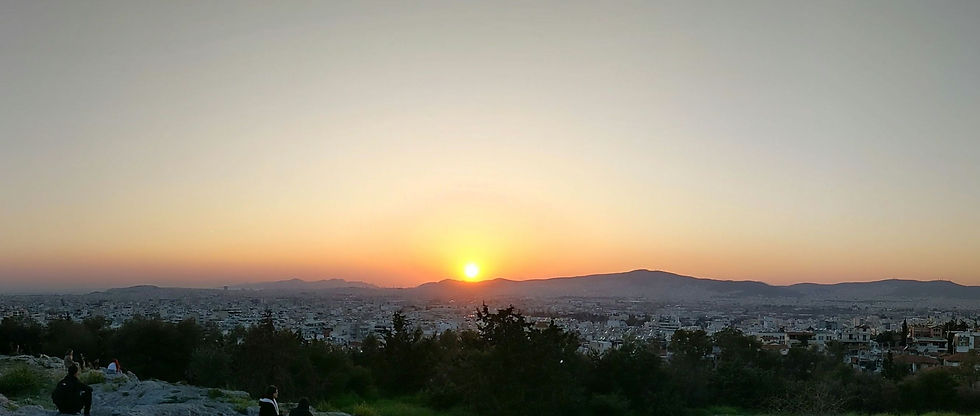





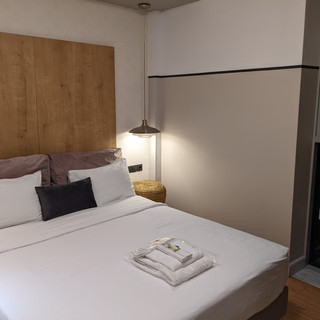



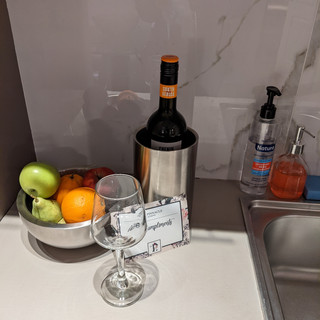











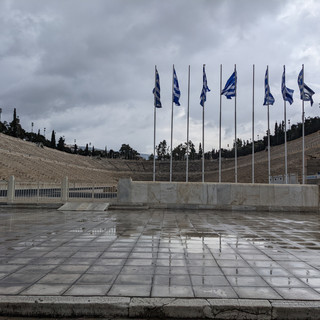



























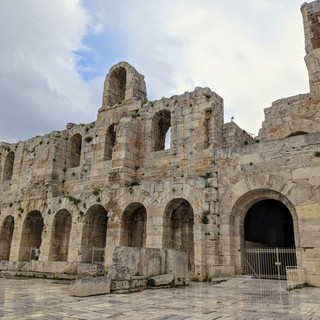











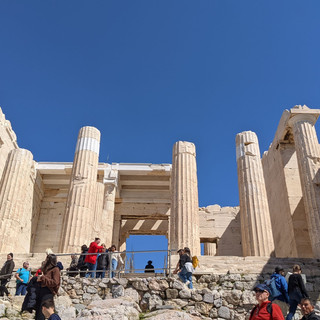











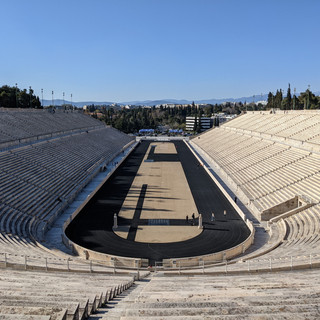







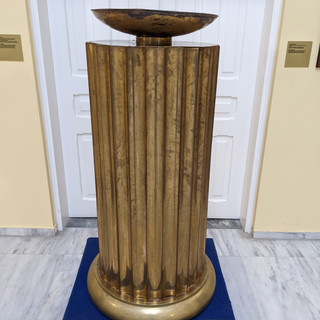







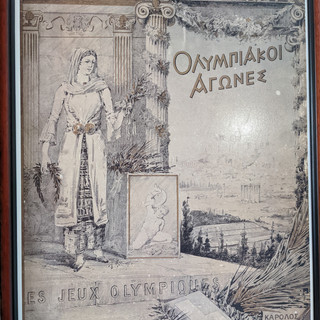

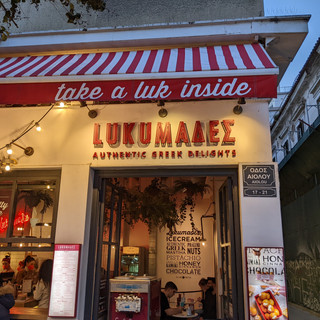







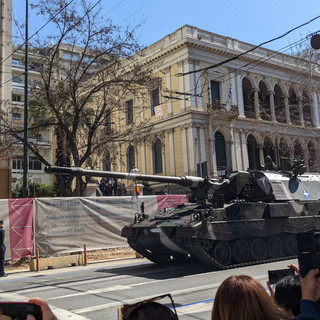











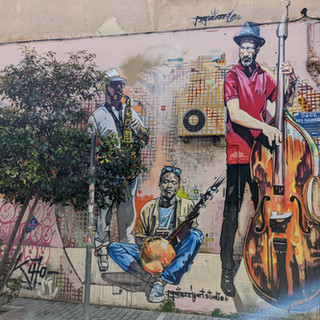





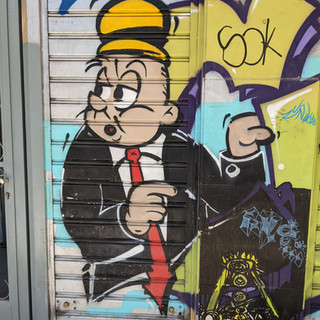













Comments